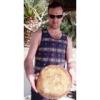
Baking with All-British Flour
Given that Rye Flour is not so common in UK shops as Wheat Flour, when one finds it, it is far more likely to be of British origin, and often, Organic too. The Bacheldre Organic Dark Rye Flour from a Welsh watermill is now the only flour I use to keep my rye sourdough culture properly fed. It is very dark, coarse, highly fermentable and thirsty, and produces breads of outstanding flavour. The Doves Farm Organic Light Rye is less impressive in these areas, but, its performance in producing a better dough structure is undeniable.
I'm trying to work towards using my local miller as a source for all the wheatflour I use at home. It means karting 7kg of flour at a time on the train back home, but I am feeling the need to move away from relying on industrially-milled flour, and come up with exceptional bread quality on all levels, using locally-grown organic flour from traditional sources. I achieved mixed success with this round of baking, but have produced much that I am very happy with, and a clear direction of the changes needed to induce improvement, and ultimately, fulfilment in the project.
•1. All-British flour and 2 Leavens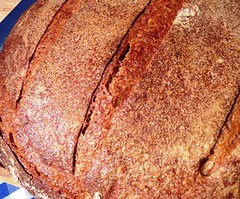
Here is the formula for a bread dough raised with 2 leavens, and using only British Organic flour from traditional sources.
|
Material |
Formula [% of flour] |
Recipe [grams] |
|
1. Rye Sour Elaboration 1 |
|
|
|
Stock Rye Sourdough |
|
20 |
|
Bacheldre Organic Dark Rye Flour |
|
60 |
|
Water |
|
100 |
|
TOTAL |
|
180 |
|
|
|
|
|
2. Wheat Levain Elaboration 1 |
|
|
|
Stock Wheat Levain |
|
54 |
|
Gilchesters Organic Pizza Flour |
|
100 |
|
Water |
|
60 |
|
TOTAL |
|
214 |
|
|
|
|
|
3. Rye Sour Elaboration 2 |
|
|
|
Elaboration 1 [above] |
|
180 |
|
Bacheldre Organic Dark Rye Flour |
|
150 |
|
Water |
|
250 |
|
TOTAL |
29.63 |
580 |
|
|
400g retained |
180g returned to stock |
|
4. Wheat Levain Elaboration 2 |
|
|
|
Elaboration 1 [above] |
|
214 |
|
Gilchesters Organic Pizza Flour |
|
200 |
|
Water |
|
120 |
|
TOTAL |
35.56 |
534 |
|
|
480g retained |
54g returned to stock |
|
5. FINAL DOUGH |
|
|
|
Rye Sourdough [above, 3.] |
29.63 [11.11flour, 18.52water] |
400 |
|
Wheat Levain [above, 4] |
35.56 [22.22flour, 13.34water] |
480 |
|
Gilchesters Organic Pizza Flour |
48.15 |
650 |
|
Gilchesters Organic Farmhouse Flour |
18.52 |
250 |
|
Salt |
1.2 |
16 |
|
Water |
38.14 |
515 |
|
TOTAL |
171.2 |
2311 |
|
Overall % Pre-fermented Flour |
33.3 |
|
|
Overall % Hydration |
70 |
|
Method:
- Elaboration One on Saturday evening, 19:00. Elaboration Two Sunday morning 09:00
- Dough mixed Sunday 17:00. Initial Bulk Proof for 2½ hours. Retard overnight.
- Divide and shape 08:00 Monday. Set to prove in Bannetons
- After cutting, bake using steam and masonry at 13:00
- Cool on wires.
Notes:
- Too much pre-fermented flour, all-told in the formula. The rye sour needed rescuing, but was good by the time of dough mixing, and added at the right quantity. The wheat leaven was too ripe, and too much added. There is need to take account of the greater ash content in this flour; even though it is labelled "Pizza/Ciabatta" flour, it can hardly be described as "00"! The colour is a greyish white.
- I did not want to retard overnight, but had little choice. The rye sour needed some care and attention. As a result the wheat leaven was over-ripe, and it was early evening, so I had to retard, rather than stay up until 4 in the morning!
- I miscalculated the salt! At 1.8% on flour, there should have been just over 24g added. This is extremely significant in terms of the dough performance.
- I adjusted the water level upward, only slightly, but feel 70% is the best proportion of water to be adding to this flour
- Some information from the flour bags is attached in photographic form. Please do not take any notice of the claim that this is "Strong" flour. High protein [and mineral content], most certainly. High in gluten forming proteins, definitely not! Personally, I wish this claim had never been included in the marketing of this flour. It may well cause numerous customers to be seriously put-off from buying in the future. I want to learn how to make good bread with this flour, and I know it does not possess some of the properties most often associated with strong bread flour. However, I know it is possible, and now know and understand the significance of the notes I have listed above.
- I have been further reflecting on the use of utterly untreated flour. Thus creating a thoroughly different animal for the baker to deal with. How to up the ante, and increase skill and knowledge levels to retain control of the fermentation and dough development when adding in all the further variables of a less consistent performance in the flour. This is to be the new "bar" to jump over.
- Onward and upward in the future!
Once rescued, I gave the rye sour dough one further elaboration, prepared a scald, and readied myself to make a large batch of this paste; very nearly 4kg...by hand!
|
Material |
Formula [% of flour] |
Recipe [grams] |
|
1. Rye Sourdough [elab 3] |
|
|
|
Stock after Elaboration 2 |
|
180 |
|
Bacheldre Organic Dark Rye Flour |
|
532.5 |
|
Water |
|
887.5 |
|
TOTAL |
80 [30flour, 50water] |
1600 |
|
Note: further leftover for stock |
|
[80] |
|
|
|
|
|
2. Scald |
|
|
|
Doves Farm Organic Light Rye Flour |
20 |
400 |
|
Organic Barley Malt Syrup |
4.5 |
90 |
|
Organic Blackstrap Molasses |
6 |
120 |
|
Coriander [ground fresh] |
1 |
20 |
|
Salt |
1 |
20 |
|
Boiling Water |
35 |
700 |
|
TOTAL |
67.5 |
1350 |
|
|
|
|
|
3. Final Paste |
|
|
|
Rye Sourdough [from above] |
80 |
1600 |
|
Scald [from above] |
67.5 |
1350 |
|
Doves Farm Organic Light Rye Flour |
17.5 |
350 |
|
Bacheldre Organic Dark Rye Flour |
12.5 |
250 |
|
Gilchesters Organic Pizza Flour |
20 |
400 |
|
TOTAL |
197.5 |
3950 |
|
Overall Pre-fermented Flour |
30 |
|
|
Overall Hydration |
85 |
|
Method:
- Give 3rd elaboration to rye sourdough and leave to ferment through for 14 hours. At the same time make the scald. Add molasses and malt syrup to boiled water in a pan and return to the boil. Pour this onto the flour, salt and coriander and mix to form a stiff, gelatinised paste. Cover well, and leave to cool overnight.
- Mix the final paste by combining the liquid sour with the stiff scald. Add the remaining flour and form a paste. See photographs for texture.
- Bulk prove 1 hour, then scale and mould into tins using wet hands to shape.
- Proof for 3 - 4 hours before baking in a moderate oven for 2 hours and upwards
- Cool on wires
- Note that I made one loaf in a Pullman Pan scaled off at 2kg, one loaf in "Farmhouse" tin, scaled off at 1.3kg, with the residual 650g proved in a small brotform, although it did, sadly, stick somewhat!
Photographs of the finished loaves are all attached.
Best wishes to you all
Andy
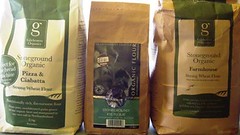

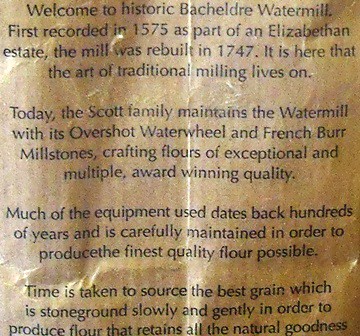
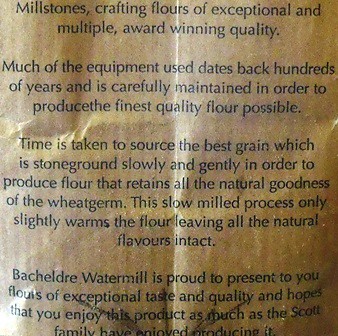
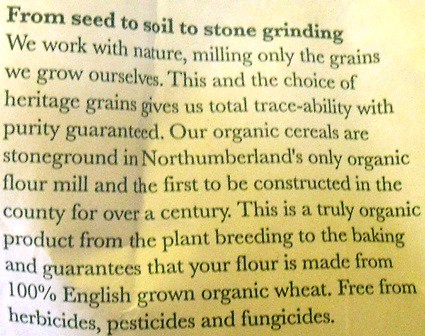
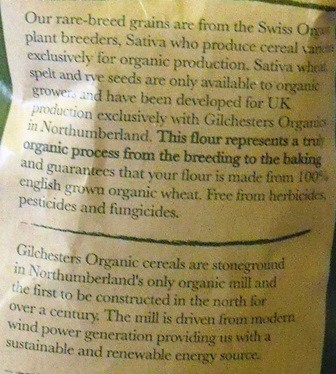
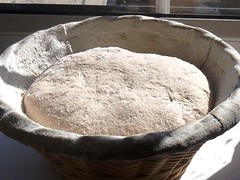
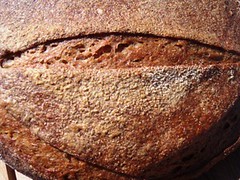
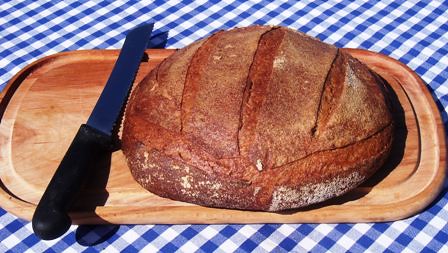


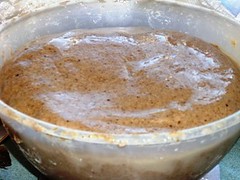






Comments
Andy,
Thank you for such detailed instructions! I especially enjoyed reading about the Borodinsky bread. Yours looks great! I am a Russian born and raised in Russia, and this bread is one of my old time favorites. The one I used to buy in Russia had caraway and coriander seeds on the top crust. I am sure your breads are VERY delicious!
Thank you,
Anastasia.
Hi Anastasia,
Many thanks for your kind words.
When I worked at Village Bakery, we used to dust the tops of these loaves with the fine cut coriander. We also use to coat the bottom of the tin with a few whole seeds to differentiate the loaf from the more plain Rossisky loaf. I loved the aroma from the topping, but the seeds on the bottom just got in the gaps in my teeth, which I really did not like.
If you look carefully in the photo you can see evidence of the coriander in the finished bread. But it is not so easy to add as a topping to a panned loaf which is baked with a lid on it!
The flavour is, indeed, very delicious
Best wishes
Andy
Hi Andy,
You're in a very fortunate situation in that you have a nearby mill to source your flour from. I know that I'd be going exactly the same route if a similar opportunity existed for me here on Vancouver Island. Apparently there is a farm on the Southern tip of the Island that mills their own grain, but it's fair ways away from where I live.
Your loaves as always, show the care and attention to the fermentation process you give your breads. The crumb you regularly achieve on your high ratio rye breads is my own personal "bar to jump over", never having come close to what you seem to do so effortlessly and consistently post after post. You mention the miscalculation on the salt and how it effected dough performance, but did it have any significant impact on the overall flavour? My guess is no, but I'd be interested to know what your impression was.
Trusting your getaway to Scotland was relaxing for you and Alison, and great to see you back and making another thoroughly enjoyable post for us to read.
All the best,
Franko
Hi Franko,
It's very good to hear from you as always.
Yes, I have long been aware that what Andrew Wilkinson is doing with Gilchesters is really quite special. I intend to be more a part of what he is doing than I have been up to now. Although, I have made a point of using his flour in College, and he did provide a thoroughly invigorating slot as a guest lecturer for the Foundation Degree students a couple of years ago too.
The reason for the seemingly effortless results in the Rye breads you mention is only down to a couple of real secrets. The first is in the control of the fermentation to produce a ripened and active sour. This is actually easier to achieve in rye than in wheat! The other factor is the character of the flour, and, I suspect this is probably where you fall down. While Canada produces the very highest quality of bread wheat flour, I just wonder if you are able to source the types of Rye flour I am able to boast of in these posts? On this score, we in the UK are most fortunate indeed. Maybe you can comment further on the rye flour you have available?
The holiday in Scotland? Awesome, many thanks for asking. Here's a couple of photos I'd meant to post earlier, but ran out of time when putting the blog post together.
The weather was fantastic, and it has to be noted that we spent time on beaches which are truly as fine as any in the whole world. But the water was soo very COLD! However, we return with suntans which are hard won in the North of Scotland, but which don't disappear quite so quickly!
And your question about the salt level. No, it has not impacted on flavour, but I regard that as revelatory of the faults highlighted in the process. The bread is too sour for the flavour profile I am looking for. That is for the reasons mentioned...over-ripe wheat leaven, and too much of it in the formula. The sourness hides the lack of salt.
I will work to try and correct these faults in the next few bakes. It's very interesting because I've been increasing the amount of pre-fermented flour in my formulae of late. Now I'm concentrating on higher ash content and totally untreated flour, I'll be reducing these levels!
Very best wishes, and more feedback to come
Andy
Hi Andy,
Regarding the rye flours I've been using, naturally that was my first thought as to why I've yet to achieve the type of crumb you manage so consistently, but I tend to think it has more to do with process than material.
The rye flour I use for starter is from Roger's Flour , a mid size B.C. mill. It's not an organic but the quality is quite good, very reliable, and reasonably priced. The flour is a whole grain and ferments easily, however because it's a little courser than I prefer, I normally only use it for starter or blended with other flours on occasion. The rye flour that I prefer to use for the bulk of a mix is from Nunweiler's Flour Co. It's an organic, with a finer texture (medium course) than the Roger's, and a superior flavour IMO. The other rye that I have used is Bob's Red Mill Organic Dark Rye. It's a finer mill than the Nunweiler's and an excellent flour but I prefer the Nunweiler's overall for flavour and grade of milling. These are both top quality flours and the cost per Kilo reflects that compared to the Roger's. Unfortunately none of the mills provide anything more than basic nutritional info on their websites so it's difficult to know how they would compare to the Bachelder.
No, I believe it's more a factor of me not maintaining a steady...and high enough temp through the duration of the bulk fermentation.That should be less of a problem now that the ambients are warming up, so we shall see if that, and a little more diligence from my end will result in that nice open rye crumb I'm looking for.
Great photos by the way! You couldn't really ask for better weather in N. Scotland this time of year could you?
Here are links to the Flour Co's I mentioned, plus one to the GovCanada Grain Commision. They don't give you a great deal of info on the products, but you might find something of interest.
Cheers Andy,
Franko
http://www.rogersfoods.com/
http://www.nunweilersflour.com/
http://www.bobsredmill.com/organic-dark-rye-flour.html
http://www.grainscanada.gc.ca/rye-seigle/rsm-mrs-eng.htm
Hi Franko,
Many thanks for the info you sent on the rye flour available to you.
I'm afraid nutritional info and other detail is not published for the flours I've been using either. I tried to test the Gilchester flour on the NIR Analyser I was using at Leeds when I was studying for my Baking Quals a few years ago. Unfortunately, the results came back as unreliable, in that the protein reading is extremely high...but this hides the fact that the gluten content is, in reality, low; by Canadian standards, VERY low! However, I've managed to take some photos which are a good representation, and the rye flour you can see is very different indeed. I think you identified it as coarse from a finished loaf sometime ago. Now you can see how coarse it really is! This flour costs me £1.75/kilo at retail prices.
Scotland: the weather was amazing!
Regarding your thoughts about bulk fermentation of the high rye. Well, the last thing you want in rye is slow fermentation, I'll agree to that. That seems to be a bit of an issue from what I am reading. It gets pretty cold in my kitchen, as you have no doubt seen from my winter posts. But, the rye sour I have is very active. Even if the final paste ends up a bit cool, it still seems to move well. I only use the 1 hour bulk which Hamelman recommends. After that, it's into the pan for final proof. The secret is in building the sour, not in the bulk!
Sorry for the delay in getting back to you.
All good wishes
Andy
looks like it's as coarse as sawdust:-) I had a finer meal using my coffee-grinder. I can imagine perfectly well how it behaves when you mix it with water:)
Hi Nico,
I was going to say that sawdust is closer to cornflour than it is to the Bacheldre, but I thought you may accuse me of exagerating...just a bit!
Ciao
Andy
Hi Andy,
Yes I remember seeing the Bacheldre previously on your blog. It's much more coarse than anything I've run across so far and I can see how a starter would have a rich feed from all the rough pieces of bran evident in the photos. As you can see from the photos below, the rye flours I'm using are nowhere near the grade of milling you have in the Bacheldre. I've always thought the Rogers was fairly course...and it is by NA standards from what I've seen, but quite a bit finer than your rye.
This is the Rogers flour I use primarily for starter.
This is the Bob's Red Mill
I'm sorry I don't have any of the Nunweiler rye to show you but it's somewhere in between these two as far as the grade of milling.
When I think back on it I realize I was having much better results with my rye breads during the late Spring and through the summer of last year than I've had with many of the loaves I've done over the past winter. Perhaps I need to think about building a heated and insulated box for keeping my starters in for next winter, as well as for bulk fermentation needs. With the cost of fuel (natural gas) being what it is it's seems like it might be the most effective solution to the problem of maintaining a steady temp.
Thanks for your input on this Andy, always a pleasure to hear from you.
Franko
Hi Andy,
Interesting stuff. I have been tripped up by some British strong/bread flour that doesn't behave like strong flour. I would love to know how to get the best out of this kind of flour as the flavour of the loaves I have made is often really good but sadly lacking in the crumb department. I will be following your future posts on this subject closely.
Cheers,
Gary
Hi Gary,
Many thanks for taking an interest in my post and adding your welcome comment.
I do understand your frustration from not achieving the kind of crumb desired in your bread when using flour which does not live up to expectation.
Perhaps you could clarify which flours you have bought which you feel have let you down? I may well be familiar enough with them to comment on how to achieve better results, although I would not want you to feel uncomfortable revealing sources if you would find that in any way difficult. I will try and make more meaningful comment in reply to your questions in the next day or so.
You ask very interesting questions, and they deserve considered reply. I will, in the meantime refer you to a comment made on Shiao-Ping's blog just recently. If you haven't seen her post, please give it a good look through, as she always makes outstanding bread; here's the link: http://www.thefreshloaf.com/node/23389/miche#comment-168247
More later, meantime, best wishes
Andy
Hi Andy,
out of all your bread this one with 4-elaborations is surely the most unusual. The look of the crumb makes me imagine it's soft and slightly chewy at the same time, while the crust just screams it's sweet, at least to me :-)
UK flour producers seem to have a strange notion of "strong flour": even Biotrend flour (sold in Lidl shops) is sold as "strong", but it's not up to the job, absolutely!
The Borodinsky is well known subject, always a pleasant encounter!
As for the multiple refreshments you seem to be using the same method used in italy by mother dough users, except that they generally use three refreshments... surprisingly to *reduce* sourness. I know your intention is the opposite, just like mine. In this period I am using a similar 2-refreshments approach to make rye bread, but with very differnt hydratations: 200% the first time and 80% the second. Total prefermented rye flour is 50%. I have to say that the flavour is really strong, really I can't complain.
Reading your experiences is always a real pleasure.
Hi Nico,
Sort of 4 elaborations, but actually, 2 elaborations of 2 different cultures: one rye, one wheat. Your analysis of crust and crumb is quite near the mark, but not absolutely. Too sour for my taste in a predominantly wheat bread.
So...yes, I know where you are coming from with the concept of multiple refreshments meaning less sour bread. BUT:
Labelled as "STRONG". Well, I sort of know where Andrew Wilkinson is coming from here, even though I don't really think it's valid as a marketing strategy, and tend to agree with your description of a "strange notion". The Gilchester flour is mineral-rich, and protein-rich too. Sadly, there is no Nutritional Information provided, but the high water absorption sugests my analysis is absolutely correct. By UK domestic standards, this flour is about average in gluten content, maybe slightly low. If ever there was an illustration of the difference between overall protein content, and potential gluten forming proteins in a flour, this is it!
BUT, if you accept Gilchesters underlying philosophy that intensively produced wheat sold on the world market is ultimately, unsustainable, whereas this local and organic single strain and untampered variety can offer a realistic and long term sustainable alternative [and I do accept this premise], then you start to see why the producer might regard his product as "strong". BUT, this does not address the expectations of his customers...I suggest!
Just to point out, for interest: UK factory bread accounts for c. 75 - 80% of total sales. This bread is made using, largely British-produced wheat now! Grown in the East Anglian bread basket from Canadian-type strains, VERY intensively; the large-scale millers regard this as a modern day miracle. Well, the crop is sprayed a multitude of times with all sorts of chemicals, and gives a yield of 8 times per hectare what is achieved in Canada, so I guess you can see why this is so miraculous. BUT, it won't work in the long term, will it?
So, what is "Strong" flour then?????? This is the question I believe Andrew Wilkinson is really trying to challenge us bakers with!
Borodinsky...well, this involved using the rye sour with 3 full elaborations! One of my best attempts thus far
Many thanks for your kind words, it's always really good to hear from you
Best wishes
Andy
Hi Andy,
You seemed enjoying your vacation so much especially the beach part. Thank you for writing about British flour, I learn a lot from your post and enjoying it so much. It is nice to be able to support local and know them well and how hard they put their flour together for us. I finally get comfortable with using my local organic flour after half year of baking experiments but still have some challenge to deal with their whole grains flour such as spelt and rye. My spelt sourdough ferment so fast and I need to pay very close attention to the dough after they are mix. As for rye flour, I’m looking for more consistency since I buy all my flour bulk from local co-op and I can feel the hydration need to be adjusted from batch to batch greatly. Thank you for the great write-up.
Kimmy
I love holidays Kimmy, and so does Alison! Going back to work is just dreaded.
I work with rye flour so much that I'm used to variable hydration. And when Gilchesters first became available, it was really variable too, some 4 or 5 years ago. But the new mill, and consistent growing methods are making it more predictable as time goes by.
It will take some work, but I think I should have this formula perfected in the 6 month schedule you mention.
Spelt has always been regarded as more fermentable than regular wheat.
I'm so happy you enjoy these posts
Very best wishes
Andy
Hello Andy,

I saw your post a few days ago and it's taken me awhile to get back.
Thanks for the details on your process for these loaves, and I admire your pursuit of the local grain.
I find the photo of your Bacheldre stoneground rye flour very interesting and upon seeing this flour I have some questions - I hope you don't mind my asking!
Do you know how the Bacheldre flour might compare to the rye meal called for in Mr. Hamelman's Vollkornbrot formula?
I wonder if your Bacheldre flour might correspond with what is called Pumpernickel flour here, or similar to what was described in this post?:
http://www.thefreshloaf.com/node/3353/hamelmans-vollkornbrot-recipe#comment-16016
I wonder too, if it's a Bacheldre-style flour that might be intended for Mr. Hamelman's Vollkornbrot.
Here's a photo of rye meal I was able to find (on the left) contrasted with the rye flour (100%) I was able to get from our local organic mill:
I wonder if the rye meal in my photo is really what would be known as cracked rye, or rye chops?
Thank you so much for your post about your British flours, Andy.
That Bacheldre flour is really something!
from breadsong
Hi Breadsong,
always good to hear from you.
There is some confusion about different grades of rye. However, the material on the left of your photo would be called Cracked Rye, or Rye Chops. It most certainly is not Rye Meal. Generally I interpret "meal" as a coarse grind of flour...but it is properly milled. The Bacheldre just about qualifies as "meal", but only just. Calling it flour is really pushing that definition.
Then we could consider what Dark Rye is? I believe Bacheldre just grind the whole grain. But sometimes Dark Rye consists of the bran and the outer sections of the endosperm...pretty much the residual from milling the whole grain to form white rye flour! Hamelman mentions this in his discussion in "Bread". I have been looking around a bit this afternoon, and came across this which is pretty accurate, and has representative photos. See: http://www.wholegrainscouncil.org/whole-grains-101/types-of-rye I like this site's pictures of Cracked Rye [Rye Chops], and Rye Flakes. The discussion of flour grades reads as my own understanding.
To answer your question, yes, I believe the Bacheldre will be pretty similar to the Pumpernickel flour in Jeffrey Hamelman's formula. However, I have never used any Pumpernickel flour myself, so I am not able to provide any definite answer to that.
All good wishes
Andy
Hello Andy,
Thanks so much for your explanation, and for the very helpful link.
I'm going to talk to the local organic mill and find out more about how they mill their rye, as I'm curious to see how their rye flour fits into the definitions on the wholegrainscouncil.org website (and also curious to see if they can get, or mill, a coarser type of rye flour, like your Bacheldre!).
And I meant to say before, lovely pictures of Scotland, too!
Thanks again for the information, Andy; it is very much appreciated.
:^) from breadsong